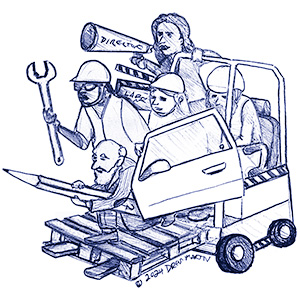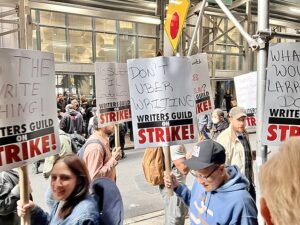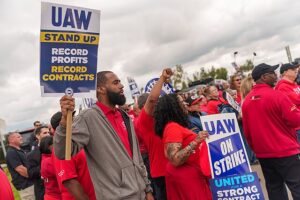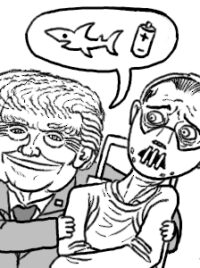Has Labor Reawakened?
For the past four decades the labor movement in the United States has been somnolent. Ever since the administration of Ronald Reagan broke the Professional Air Traffic Controllers’ (PATCO) strike in 1981 organized labor has staggered from defeat to defeat. Its most effective weapon, the strike, atrophied. Too often when unions chose to strike, usually as a last resort in their battles with employers, they lost when their adversaries broke strikes with replacement workers. By 1981 union power had declined substantially from its high point, c. 1947-1971, when fully one-third of all non-agricultural workers belonged to unions and even many nonunion enterprises offered their employees wages and benefits comparable to those achieved through collective bargaining. Over the next four decades the proportion of union members in the private sector steadily declined until it fell to six percent, a level not experienced since before the First World War. By the second decade of the twenty-first century only unionized public employees kept total membership above the ten percent level by and even among such workers organized labor suffered significant defeats in the twenty-first century. Only public school teachers unions made few, if any, inroads among public employees in Sunbelt states, nearly all of which outlawed strikes or union membership by public employees. Most remarkably, in the state that had pioneered public employee unionism and collective bargaining, Wisconsin, a Republican state administration amended state labor law to undermine the stability of public employee unions and their ability to bargain collectively, causing a decline of more than one-third in union membership. Shortly afterward, the Supreme Court delivered a ruling that outlawed union or agency-shop agreements for public employees.

Artist: Drew Martin
A similar dynamic occurred nationally. From the 1970s to 2021 it mattered not whether Democrats or Republicans held power in Washington. When Republicans controlled the White House or Congress (1973-77, 1981-89, 2001-08, and 2017-20), the federal courts, the National Labor Relations Board (NLRB), and even the Department of Labor favored capital over labor. When Democrats took command (1977-80, 1993-2000, 2009-16), organized labor fared marginally better at the hands of its political allies. The NLRB and the Department of Labor acted as labor’s allies but Democratic economic advisers and policy-makers pursued policies that weakened union power. The Jimmy Carter administration deregulated the transportation sector setting off a form of deregulated competition that decimated the Teamsters power in over-the-road trucking and weakened unionism in the airline and railroad industries. Carter’s primary economic advisers advised him that union members were the enemy of the nonunion workingclass majority. Bill Clinton’s administration directed equally hard blows at its trade union allies. It used its political muscle to push the North American Free Trade Agreement through Congress and to admit China to the World Trade Organization (WTO), opening the domestic market to Chinese imports. The result of such policies was the wholesale abandonment of domestic manufacturing and a widening rust belt across the nation’s midsection. With the election of Barack Obama in 2008, labor’s hope for relief awakened only to be dashed. In the morass of the financial crash of 2008-09, the administration saved the banks, bailed out the bankrupt automobile companies, stabilized the economy but required workers to offer concessions, and mortgagees, often the self-same workers, to fulfill their financial obligations or lose their homes.
The result of four decades-plus of such policies was ever-widening economic and social inequality. By 2020 economic inequality surpassed the level of 1929 and approached or exceeded that of the “gilded age.” For four decades only the top ten percent, and more especially, the top one percent enjoyed substantial rising incomes and amassed a growing share of national wealth. By 2020 the US had become the most unequal of all major advanced economies and the one with the least measurable opportunity for social and economic mobility. For more than forty years too large a proportion of the working population experienced little to no rise in their basic real income. Too many had to work too much (excessive overtime or second or third jobs) or send multiple members of the household into the labor market to satisfy basic needs, to maintain adequate care, or obtain the education necessary for decent employment opportunities. All while executive compensation and returns to capital grew excessively ever widening the gap between those who commanded and those who obeyed.[1]
How do we explain the contrast between the US of c. 1947-72 and the US, c. 1981-2020, between a relatively egalitarian polity with substantial working-class power and a grossly unequal polity with minuscule working-class power? Let me offer a few suggestions. The US emerged from World War II with unchallenged economic supremacy. The war had destroyed the economies of all the nation’s major prewar competitors. The war had also solidified a union presence in the towering heights of the economy—basic metal manufacturing, automobile production, petro-chemicals, consumer durables, and transportation. Three books that appeared in the 1950s and 1960s—Adolph Berle Jr.’s The Twentieth Century Capitalist Revolution and John Kenneth Galbraith’s American Capitalism: A Theory of Countervailing Powerand The New Industrial State—dissected the lineaments of the “new order.” According to Berle, the corporate economy that he and Gardiner Means had examined early in the Great Depression—primarily the separation between corporate ownership and corporate management had become the dominant aspect of the modern corporation. Because corporate managers did not own the firms that they managed and their compensation came in the form of salary and not return to capital, they did not have to focus on profit maximization. Instead, they could act as responsible corporate citizens by caring for their employees, including those in unions, and benefiting the communities in which they were located in manifold ways. Galbraith took as given the separation between corporate ownership and corporate management and postulated that what kept the entire system in balance was the countervailing power balance among big business, big agriculture, big labor, and big government (that is, the New Deal administrative state). By the mid-1960s as the system envisaged by Galbraith seemed unassailable, he argued in his second book that the demands of modern technology pushed all economies toward a similar destination and power arrangement and that even the Soviet Union would come to resemble the United States.
How, then, did this seemingly unassailable balanced political economy fall apart? The answer is not too complicated. First, the US’s global economic dominance diminished. Rebuilt economies in Germany, Japan, France, and Italy later to be joined by South Korea, Taiwan, and the BRIC nations, Brazil, Russia, India, and China, cut into the markets of their US competitors. In automobiles, steel, petro-chemicals, and consumer durables US corporations lost market share and faced falling profit margins. Two OPEC-inspired oil embargos in the 1970s further undermined the domestic economy. By the late 1970s, “stagflation,” accelerating inflation despite loose labor markets and declining corporate profits, plagued the US economy and presaged the death throes of the New Deal political and economic order, the system that had created the widely shared prosperity of the postwar era.
The ideas and policies that came to mark the neoliberal political order that prevailed from the 1980s to 2020 originated in corporate and conservative circles during the New Deal era but lacked wide purchase while the system generated rising real incomes and greater equality. As inflation threatened living standards, reduced corporate profits, and pressured government budgets, neoliberal ideas gained greater purchase. Neoliberal policies loosened government regulation, provided tax relief for investors and job-creators, and enabled employers to attack union and worker power in what the then president of the UAW, Doug Fraser, described as a corporate class war. Reversing Berle’s capitalist revolution, corporations were now to serve only one constituency, their shareholders. Proft maximization became the rule even when it required employee layoffs and community devastation with plant relocations overseas. To complete this twenty-first century “capitalist counter-revolution” corporate boards linked executive compensation to stock options whose value rose and fell in relation to company profits. The result a trail of devastation for communities deserted by their primary employers, frustration for workers left without jobs or unions to defend them where they remained employed, and a federal government bereft of the tax income to balance its books or invest in its people and the nation’s future.
Why, then, has labor suddenly awakened? If we examine the past three years or so of worker and union activity, what do we see? We see worker resistance and union revival across the economy. We also see for the first time since the post-World War II years community sentiment that endorses unions at least in the abstract.[2] We also have a federal administration that endorses union power as shown in recent actions by the NLRB and the Department of Labor as well as a president who claims to be the most prounion ever and even walked a picket line for the UAW. Far more important, however, has been the recovery of the economy from the depths of the Covid pandemic. For the first time in decades employers face a tight labor market in which workers can expect to find new jobs if they quit existing ones. The option to exit without having to sacrifice alternative employment and income has stimulated workers to demand voice where they work. Thus workers in jobs once considered nearly impossible to unionize such as Amazon warehouses and Starbucks cafes have demanded union recognition, signed union cards, and won NLRB union recognition elections. Simultaneously, workers in enterprises that have long been unionized have rebelled against concessions granted when labor markets were loose, and firms threatened by bankruptcy. Other union members who had previously granted concessions now rebelled against new technologies that threaten their job security or stream of income.

There is scarcely a sector of the economy that has not been affected by the labor upheaval. Unions and their members have sought aggressively to restore the wages, benefits, and power on the job lost steadily during the decades of neoliberalism. On the Pacific Coast members of the International Longshore and Warehouse Union used their power at vital nodes for trans-oceanic shipping to maintain the high wages and job security that resulted from their control over the loading and unloading of cargo containers, the innovation that transformed global trade. Operating railroad workers walked off the job on the major trans-continental freight railroads in a rebellion against company rules that intensified the burden of work, threatened their health and safety, and restrained wage growth. Their threat to the national economy led the Biden administration to enjoin the walkout but to grant the workers many of their demands, except for the right to multiple paid days for medical leave. Yet persistent worker threats to railroad traffic led the companies to concede additional paid medical leave to their employees. But even employees in the most unlikely places unionized and walked off their jobs to demand better conditions, most notably in colleges and universities. Graduate students walked off their jobs across the entire University of California system, numbering in the many thousands, to demand relief from the state’s high cost of living in the form of substantial salary increases, rent subsidies, and improved health insurance. And they won. Most Democratic states allowed graduate students to unionize and bargain collectively but the NLRB under Republican administrations had ruled that graduate students at private institutions were not employees as defined by labor law and hence lacked a basis for collective action. This enabled such institutions as Harvard, Yale, and Columbia, among others, to resist collective action by their graduate students. When the Biden NLRB ruled that graduate students in private institutions who were employed as researchers or as actual teachers were indeed employees previously resistant universities began to recognize student unions and to bargain with them. Unions even spread among undergraduates when dining service workers and dormitory assistants demanded the right to unionize and bargain.
There seemed no limit to where the right to unionize, to bargain collectively, and to achieve real gains might go. In the city and county of Los Angeles, hotel workers (members of Unite-HERE) walked off the job to demand higher wages as protection against California’s high cost-of-living as had the state’s graduate students. A second major economic sector in Southern California experienced strikes by its “employees,” film and television production. Screenwriters and actors were both threatened by new forms of television and film production. The streaming of both television and film undercut the income writers and performers received from syndication and residuals. No reliable data existed as to the actual total worldwide audience for a streamed TV show or film, and streamed productions unlike more traditional television and film could be completely erased with the flip of a switch. Artificial intelligence (AI) and facial recognition software potentially threatened writers and performers. Writers worried that AI might be used to produce scripts in their place and actors worried that facial recognition might eliminate their personal appearance income. Already streamed TV shows had shorter seasons than traditional television requiring fewer writers who received less compensation for fewer scripts. Thus members of the Writers Guild of America (WGA) went on strike demanding minimum staffing for writers’ rooms, guaranteed weeks of employment, improved accounting of total streamed income, and protection against the arbitrary use of AI. As their strike threatened the opening of the new fall TV season and limited the production of new streamed shows, networks, producers, and streaming companies conceded to the writers’ demands, offering minimum staffing levels for writers’ rooms, fuller accounting of streaming income, and protection against AI. Actors organized in SAG-AFTRA struck soon after the writers and made comparable demands. They had a significantly larger membership but most of the members were little known actors who played bit parts and were scarcely recognizable to the audience. What gave SAG-AFTRA real power was the participation of film stars with instant recognition and huge audiences. In the end, SAGAFTRA members won an agreement as generous as that of the screenwriters.
The truly remarkable labor triumph occurred in the automobile industry. For too long, the UAW had atrophied as an administration caucus first established by Walter Reuther in the 1950s dominated the union autocratically. Over time the caucus calcified, became self-serving, and disregarded the needs and voice of its members. By the twenty-first century its leaders had grown corrupt as well as contemptuous of their members. By 2022 its last two presidents had been indicted by the federal government for corrupt practices (stealing millions from the union), tried in court, convicted and imprisoned. The Department of Labor then compelled the UAW to sign a consent decree that for the first time enabled members to vote directly for their leaders. The result was a slate of insurgent officers, most notably President Shawn Fain, who promised militant action to eliminate the concessions to employers that the union had granted in the aftermath of the 2008 financial collapse. No more two-tier wage system in which newer employees earned substantially lower wages, substantial wage increases for all to match the increases in executive compensation, and health insurance and guaranteed pensions comparable to what the union had won in the 1950s. Instead of following the past UAW practice of selecting one of the big three US automobile companies to strike, Fain pursued a more innovative strategy. The union called its members out at specific plants of all three companies—General Motors, Ford, and Stellantis—while members remained at work at the remaining plants. As the strike dragged on, the UAW would call out its members at additional plants, raising the pressure on the companies. President Biden even became the first US president to join a union picket line. By engaging in a selective series of walkouts, the UAW reduced the financial costs of the strike and eased the pressure on its strike fund.
The strategy worked. First, General Motors and then Ford and finally Stellantis settled with the union and on generous terms. The three-year contract eliminated tiered wages, provided a 25-40% wage increase over its duration, and improved pensions and other fringe benefits. Stellantis even agreed to reopen a plant in Belvidere, Illinois that it had previously scheduled to close and to build a new electric battery factory in town.
Using the momentum of its victory over the “big three,” Fain and the UAW resolved once again to unionize the nonunion plants in the South, where previously the union had experienced nothing but failure. The UAW decisively won a union representation election at the Volkswagen plant in Chattanooga, Tennessee, the first major victory in the South in more than half a century. Victory there raised the union’s hope for a second triumph at Mercedes’ plant in Alabama. There, however, the union narrowly lost a hard fought election, leading the UAW to demand a re-election, owing to Mercedes’ alleged illegal practices during the initial attempt. For the moment its defeat in Alabama has put the UAW’s effort to unionize BMW and the Japanese and Korean implants in the South in peril. Once again, as happened in two earlier efforts by the CIO to unionize the South and attack the region’s reactionary political influence regionally and nationally, failure appears as likely as success.
The UAW was not alone in achieving success in the Fall of 2023. By then, as noted above, screen and television writers as well as actors had won their strikes against their employers, as also had the 100,000 plus graduate students at the University of California. The UAW had so many graduate student members by 2024 that several sat on the union’s executive board and proved even more militant than their auto worker brothers and sisters.

President Joe Biden walks along the UAW picket line and engages with union members at the GM Willow Run Distribution Center, Tuesday, September 26, 2023, in Belleville, Michigan. (Official White House Photo by Adam Schultz)
Organizing and strike action also swept across the sales and service sectors, which employ far more workers than manufacturing. Employees at Amazon, especially its warehouse workers, Trader Joe’s, bookstores, and other retail establishments formed unions and occasionally struck. Like most retail and service establishments, these either refused to recognize unions or negotiate a first contract with those few that they recognize. Indeed, the unions and the NLRB have accused these employers of engaging in persistent illegal antiunion actions.
The one exception to this story of union failure in retail is Starbucks. Among all the retail establishments Starbucks employees had unionized at the largest number of company stores, still only a small minority of the company’s 19,000 establishments though still a significant number. At first, Starbucks, like the companies above, engaged in blatant antiunion activities, including firing union activists, and denying union members benefits granted nonunion employees, as proved by the NLRB. It also refused to negotiate a first contract at any of its unionized stores. Then early in 2024 its new CEO, who replaced founder Howard Schultz, awarded union members the same wage increases and improved benefits already granted nonunion employees. He also promised to negotiate a first contract with employees at unionized stores. The question remains whether this shift in company policy will lead to unionization at a vast majority of unorganized Starbucks’ stores.
More troubling still is the reality that all the strikes and union organizing in 2023-24 did not increase union density. Indeed the total number of new employees continues to grow more rapidly than that of union members. More threatening still, Amazon, Trader Joe’s, and Elon Musk are all challenging the constitutionality of the National Labor Relations Act in federal court. And with a presidential election impending in November, the threat to organized labor only worsens. Were Trump to be elected and Republicans to retake power in the Senate labor might face a parlous future. The NLRB, as has been typical during Republican administrations, would prove to be more amenable to the interests of employers than to those of workers, and this time likely even more so. Even worse there would be no restraint on the federal judiciary in which a majority of the circuit courts of appeal have established clear antiunion, anti-worker sensibilities. To put it simply the recent successes of organized labor and its future prospects depend on the results of the November elections.
[1] How Democratic as well as Republican administrations and their common commitment to neoliberalism undermined union power can be followed in the following histories: Melvyn Dubofsky, “Jimmy Carter and the End of the Politics of Productivity,” The Carter Presidency: Policy Choices in the Post-New Deal Era, eds., Gary Fink and Hugh Davis Graham (1998), 95-116; Nelson Lichtenstein, A Fabulous Failure: Bill Clinton and the Transformation of American Capitalism (2023); Gary Gerstle, The Rise and Fall of the Neoliberal Order: America and the World in the Free Market Era (2022).
[2] I take such opinion surveys as those conducted by the Gallup Poll with a grain of salt. Too much depends on how the questions are posed and external circumstances at the time, that is whether or not unions have acted in a manner that might cause discomfort for non-participants.

